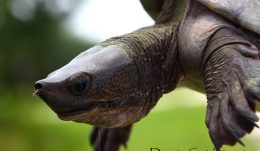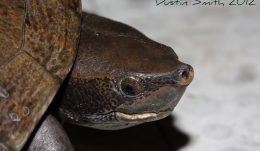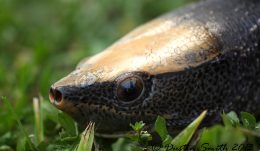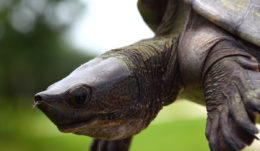- Locations: Guatemala
- Active dates: 2019 - ongoing
Aims
To identify where to focus limited conservation resources and to get a baseline against which to measure the impact of conservation work, this project aims to establish the population size at two key sites in Guatemala. This will be done by using PIT tags (small tags that are very similar to the microchips we use to identify household pets), a method that has already been tested in this species and no negative effects have been seen. By counting and recounting the number of individuals with these tags it will allow us to estimate how many turtles are currently in the wild population at these two key sites. This project will also carry out the very first survey of the species ever completed at one of the two sites.
Species
Background
In 2019 the EDGE EDBE expedition will travel to Guatemala and support the work carried out by the Wildlife Conservation Society (WCS) on the reptile with the second highest EDGE score, the Central American River Turtle (Dermatemys mawii). The Central American River Turtle is the last living descendant of the family Dermatemydidae, and became separate from all other living turtles around 80 million years ago. It therefore represents truly irreplaceable evolutionary history, but it is close to being lost from our planet forever. The species is entirely aquatic (can barely move or hold the head up when out of the water) and herbivorous (eating figs, flowers and leaves) and originally inhabited lakes and rivers in the southern part of Mexico and the north of Belize and Guatemala. The habitat which this turtle relies on is being lost, and the species is also hunted locally for its meat.
The Central American River Turtle populations have declined severely in the last decades, and the species is not found in much of its historical distribution area. The turtle was considered by the Turtle Conservation Coalition as one of the top 25 tortoises and freshwater turtles most likely to go extinct in all four of their reports (2003, 2007, 2011 and 2018). It is also listed as Critically Endangered in the IUCN red list and listed on Appendix II of CITES. In Mexico and Belize the species has been more widely studied but little is known about the distribution, size and demographics of the populations in Guatemala.
In 1992 Consejo Nacional de Áreas Protegidas (CONAP) hunting regulations prohibited the hunting and capture of the turtles throughout Guatemala but unfortunately this practice still occurs today. Because of their large size and high meat yield, hunters can make a sizeable profit when they sell them on the market. This has led to hunters over harvesting and selling the turtles instead of just hunting enough meat for their own consumption. Hunters are also selecting for larger turtles, leaving behind immature juveniles. This means the populations are unable to reproduce as effectively, leading to a rapid decline in population size. Evidence of this selection for size can also be seen in recent surveys of populations. Where turtles were often 20kg in weight now the turtles being surveyed in Guatemala are no more than 11kg.
The expedition is supported by the Erasmus Darwin Barlow fund to build the capacity of two early careers conservationists from within the UK. The two EDBE award winners this year are Freya Marshall and Alice Litchfield.
Alice’s background is as a Geographer after completing an undergraduate degree in 2018 at Manchester Metropolitan University. After completing a research project with the Wild Planet Trust and gaining employment at Bristol Zoological Society, her focus has been on science communication and informing visitors on animal biology and conservation issues and resolutions that the society’s work towards. Freya graduated from the University of Glasgow last year with a BSc (Hons) in Veterinary Biosciences. after spending time in Vietnam volunteering at an animal rescue center her focus has been on conservation fieldwork and raising awareness of species that are relatively unknown to the public.
Gallery



